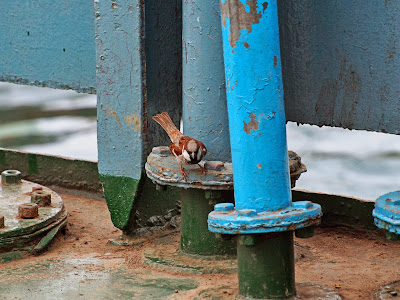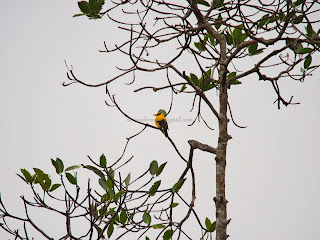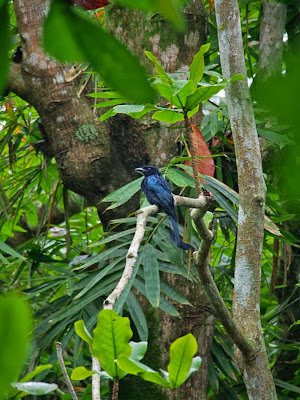View previous post here.
Now with the threat of Cyclone Phailin expected to hit the Odisha coast tomorrow, I was once again reminded about my Andaman trip because I had heard that Phailin had prevented a few flights from landing in Port Blair!
 |
| Pic courtesy: http://www.wunderground.com/blog/JeffMasters/show.html |
Let me confess. One of the reasons I had agreed to go was the opportunity to do something a little different. When you think Andamans, the first thing that pops up in everyone's mind are pristine beaches. My mind was thinking 'green' instead of 'blue' but it also thought of so many other colours! Andaman has a rich bird population many of which are endemic.
First thing I did sometime in mid-august, before packing my stuff for Andaman's, was to type out a list of birds (and reptile) I hoped to see. I admit, four days with a rather cramped schedule was not exactly ideal for birding, but the optimist in me was not about to give up. My list include some 69 birds, including the Narcondam Hornbill though I wasn't going even remotely close to a boat to Narcondam!
If you are a serious birder, Andaman should be on your list of 'to do' birding spots. The only issue is that you have to set aside a good 10-12 days for it. Birding in Andamans will require you to travel by road and by boat so you have to be prepared for spending time for that.
The fundamental mistake I made, and I admit it, is that I was a little unprepared. Since the primary reason for the trip was a book release I carried photography gear for the occasion. Bird season was still a couple of months off and I did not expect to see much in that little time I had!
Mistake number 1: My longest and fastest lens didn't make the trip because I wasn't keen to lug some 5.5 kgs to a book launch.
Mistake number 2: I took a 75-300 mm tele-zoom hoping that the digital 2x in the camera would help. (Don't call me an idiot, I know I'm one!)
Mistake number 3: I left my binoculars behind, partly because I wanted to carry less weight on my rain forest trek and partly because I didn't want to be clapped in the Cellular jail for snooping around sensitive military installations!
Mistake number 4: I completely misjudged the weather and didn't carry my rain cover for the gear. It was in the camera bag with the Zuiko 300mm f2.8 that I so injudiciously left behind.
Mistake number 5: I left all my Manfrotto support gear including the tripod, monopod and the 393 heavy lens support behind. I carried only a small tripod. Reason; less luggage more comfort!
So there I was, standing in Andaman Teal House ruing the decisions regarding my gear. Now I have some pictures that I'm really ashamed of!
The rain didn't need a reason in Andamans. It just poured whenever I hoped it wouldn't. The end result was that these are the worst set of bird photos I ever got. Not that I'm a skilled photographer but some of these pics are worse than novice level!
The first birds were the rock pigeons that were fluttering about the roofs of our guest house.
They seemed a little darker than the ones we see back on the mainland but I could be mistaken.
The drongos and hill mynas were too far to get a decent picture so didn't bother considering that I had a trip to Chidiya Tapu and Havelock planned.
Since there was some confusion regarding the book release and the rather unpredictable weather, my trek plans to Chidiya Tapu had to be shelved but I was determined to do a trip just to see how the place was in the rain. A detour to Sippy Ghat was a waste of time. I had got a white bellied sea eagle on my last trip there but this was off season and was hoping for some early migrants but I only lost a good hour driving up for nothing.
An hour in Chidiya Tapu (Bird Island) on 04/09/2013
By the time we reached Chidiya Tapu it was past 4.30 and the light was fading fast. The continuous drizzle wasn't helping either. When you turn left at the Forest Guest house to Munda Pahar beach, the road passes through a bit of forest. The first sign of the rich bird life came into view as we turned a sharp corner. The Emerald Dove was on it evening stroll, picking some juicy tidbits from the road.
 |
| Emerald dove on the road to Munda Pahar |
I knew if I stepped out of the car it would be the last I saw of it. I squeezed of a couple of shots before I tried to get out without attracting its attention. I failed in that endeavor and the bird took off.
There were a fair number of cars in the parking lot at Munda Pahar and the beach had it's share of noisy drunken tourists. My eyes, however were on the trees. I could hear the squawking of the parakeets high up in the dense canopy. There seemed to be birds everywhere but I couldn't really get any lined up in my sights. The sky was a somber grey, as if to reflect my mood, which was also getting increasingly darker because of the drizzle.
I couldn't set my aperture wider than around f8 because the birds were to high up and I needed a little DOF. Anything smaller would mean a slow shutter speed and at 300mm with shaky hands the pictures would be completely out of focus as the one above shows. Even hiking the ISO to between 1600 and 4000 wasn't really helping. At that moment I regretted leaving my big lens behind. There were plenty of birds and in the half an hour I was in Chidiya Tapu I got at least four endemics.
 |
| Andaman wood pigeon with an oriole and parakeets. Too far for my lens! |
 |
| Red breasted parakeet |
 |
| Collared kingfisher |
 |
| Long tailed parakeet |
En route to Mount Harriet on 05/09/2013
The other place I had in mind was Mount Harriet and more than birds it was reptiles I was hoping to see. My trek in Chidiya Tapu was washed out so I was hoping I would encounter some snakes at least in Mount Harriet. It was a truly wonderful experience to be tramping along alone in a rain forest but it was too dense for any bird sighting. The house sparrows were everywhere including on the ferry to Bambooflat!
 |
| House sparrows on the ferry |
The only consolation was the white bellied sea eagle sitting on a barren tree and surveying the scene below. Looked like a juvenile and it wasn't looking to go anywhere.
24 hours in Havelock (6th & 7th September, 2013)
Our ferry to Havelock was scheduled to leave at 7.30 but as with all private ferries plying from Port Blair they waited to have the seats filled. Consequently, our departure was delayed by an hour. Hanging around on the jetty along with the passengers were the usual sparrows....
....and also a lone bird whose identity I really wasn't sure of. It looked like one of the plovers (Pacific Golden) in non breeding winter plumage but I stand to be corrected.
 |
| Is this a Pacific Golden plover? |
After a rather late breakfast in Nala's at the Havelock jetty we reached our resort a little after half past eleven. The first bird I met was this handsome fellow right near the reception.
 |
| Red breasted parakeet |
 |
| Spot the white headed starling in this picture! |
A black-naped oriole was too well camouflaged and the dense foliage wasn't making things easy.
 |
| Black-naped oriole |
 |
| Hill myna |
My niece wanted to eat a wood fired pizza that was apparently a specialty in one particular eaterie called German bakery. Though we had no clue where this place was, we decided to drive around. The evening was free because my proposed trek to the Elephant beach never materialized, courtesy the weather!
 |
| The 'Lee Meridian restaurant' & German Bakery! |
The German bakery has shifted its location to a place across the road from where it originally was. It is on the road to Kalapathar village, along the beach No.5. They now have thatched cottages too. At the end of the path along the cottages, just beyond the fence is a tree with no foliage, and on that tree was this bird trying to attract my attention!
 |
| Juvenile crested serpent eagle |
 |
| Red breasted parakeets |
 |
| Collared kingfisher |
A few meters beyond the public beach is a small shallow stream that flows into the sea. Along its edge is a bit of mangrove and dense vegetation that was swarming with many birds. Red whiskerd bulbuls were very in larger groups than I was used seeing at home.
There were so many other birds, busy flitting about their morning chores....
 |
| Another black-naped oriole |
 |
| A group of large cuckooshrikes |
 |
| Scarlet minivets |
 |
| Large cuckooshrike |
 |
| Stork-billed kingfisher |
There was no point in risking my gear and limbs (there is a lot of large drift wood on Radhanagar now and my aunt was felled by one that hit her shins!) and breakfast winds up at 9.30 in Barefoot.
I would have time for a bath before taking care of my rumbling tummy. I had been out on the beach for 3 hours.
Breakfast over, we packed up for the return ferry. The ferry was at 4 PM but since check out was at 11 we thought we'd hang around till lunch before catching our cab to the jetty.
There were more birds seeking relief from the rain like me. This emerald dove was too cold to even move a feather despite my standing right under it!
 |
| Emerald dove |
 |
| Andaman drongo |
 |
| Asian fairy bluebird |
 |
| Greater racket-tailed drongo |
 |
| Scarlet minivet females |
There were more birds I sighted but couldn't get on camera. A black eagle, common kingfisher, white breasted kingfisher, glossy swiftlet, Andaman crake, a tern and a ?bittern I couldn't identify.
I have to go back again but the weather pattern has changed completely and I have been hearing of flights being diverted elsewhere recently!
If anyhow, after reading this, you have had an inspiration to go to the Andamans for birding here are a few tips.
Travel Facts:
- Choose your season well. Many websites do mention that the monsoon is over by September but the last few years have seen rains spilling over for a couple of months further. Either way, be prepared for fickle weather.
- The light is also very unpredictable. It gets cloudy very quickly and if you are in thick rain forest it is a real disadvantage. Day starts early, as early as 5 AM, and the sunset is also consequently, much earlier than then on the mainland.
- As I said in my last post the trees are very, very tall so you need to carry your longest reaching and fastest lenses. If you have a prime telephoto things are easy but try to keep your aperture setting at f8 and manipulate your shutter using ISO settings.
- You will need a sturdy tripod or monopod. The small ones are not of any help. I was trying to take pictures of the waves with long exposures and the tripod gets shaken by the waves.
- Carry a rain cover for your gear. It can rain at the most unexpected moments.
- Don't leave your binoculars behind like me. Besides the tall trees you also have obstacles like the mangrove forests and the tides, which come in the way of good close sighting.
- Have your Pocket Guide to the Birds of the Indian Subcontinent by Grimmett & Inskipps handy. You are going to meet a lot of unusual birds that are not seen on the mainland!
- Be ready for my friends, the little leeches. Don't worry, they only drink a fraction of the blood that their mainland cousins feast on! On the beaches you have the sand flies instead of leeches.















1 comment:
Lovely avian captures!
Post a Comment